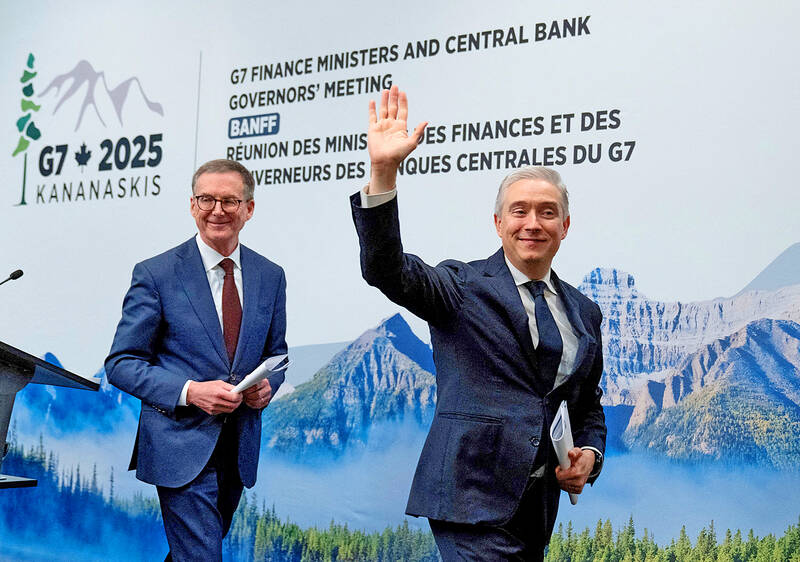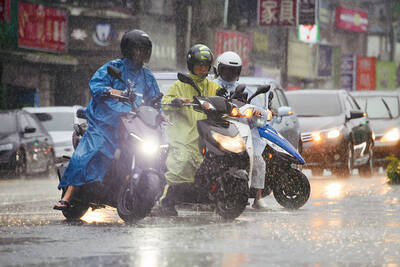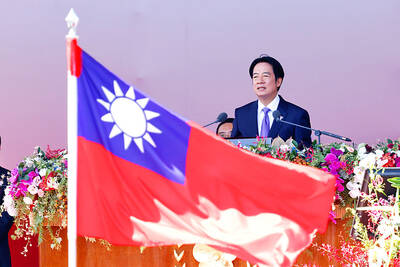Finance ministers and central bank governors from the G7 papered over their differences on Thursday, pledging to tackle “excessive imbalances” in the global economy and saying they could increase sanctions on Russia.
There had been doubt before the meeting whether it would issue a final communique, in light of divisions over US tariffs and Washington’s reluctance to refer to Russia’s war on Ukraine as illegal.
However, after three days of talks, participants signed on to a lengthy document devoid of previous language on fighting climate change, and which also softened references to the Ukraine war.

Photo: REUTERS
“We found common ground on the most pressing global issues that we face,” Canadian Minister of Finance Francois-Philippe Champagne told the closing news conference.
“I think it sends a very clear signal to the world ... that the G7 is united in purpose and in action,” he said.
The officials, who met in the Canadian Rocky Mountains, called for a common understanding of how “non-market policies and practices” undermine international economic security.
The document did not name China, but references by the US and other G7 economies to non-market policies and practices are often targeted at its state subsidies and export-driven economic model.
The G7 statement omitted mention of US President Donald Trump’s tariffs that are disrupting global trade and supply chains and swelling economic uncertainty.
The gathering sets the stage for a summit of G7 leaders from June 15 to 17 in the nearby mountain resort area of Kananaskis.
Trump would attend the summit, the White House confirmed on Thursday.
The communique called for an analysis of market concentration and international supply chain resilience.
“We agree on the importance of a level playing field and taking a broadly coordinated approach to address the harm caused by those who do not abide by the same rules and lack transparency,” the grouping said.
It also recognized an increase in low-value international “de minimis” package shipments that can overwhelm customs and tax collection systems, and be used for smuggling drugs and other illicit goods.
On the war in Ukraine, the communique also agreed that Russia could face further sanctions if it resisted a push toward a ceasefire.
“If such a ceasefire is not agreed, we will continue to explore all possible options, including options to maximize pressure such as further ramping up sanctions,” it said.

The combined effect of the monsoon, the outer rim of Typhoon Fengshen and a low-pressure system is expected to bring significant rainfall this week to various parts of the nation, the Central Weather Administration (CWA) said. The heaviest rain is expected to occur today and tomorrow, with torrential rain expected in Keelung’s north coast, Yilan and the mountainous regions of Taipei and New Taipei City, the CWA said. Rivers could rise rapidly, and residents should stay away from riverbanks and avoid going to the mountains or engaging in water activities, it said. Scattered showers are expected today in central and

People can preregister to receive their NT$10,000 (US$325) cash distributed from the central government on Nov. 5 after President William Lai (賴清德) yesterday signed the Special Budget for Strengthening Economic, Social and National Security Resilience, the Executive Yuan told a news conference last night. The special budget, passed by the Legislative Yuan on Friday last week with a cash handout budget of NT$236 billion, was officially submitted to the Executive Yuan and the Presidential Office yesterday afternoon. People can register through the official Web site at https://10000.gov.tw to have the funds deposited into their bank accounts, withdraw the funds at automated teller

COOPERATION: Taiwan is aligning closely with US strategic objectives on various matters, including China’s rare earths restrictions, the Ministry of Foreign Affairs said Taiwan could deal with China’s tightened export controls on rare earth metals by turning to “urban mining,” a researcher said yesterday. Rare earth metals, which are used in semiconductors and other electronic components, could be recovered from industrial or electronic waste to reduce reliance on imports, National Cheng Kung University Department of Resources Engineering professor Lee Cheng-han (李政翰) said. Despite their name, rare earth elements are not actually rare — their abundance in the Earth’s crust is relatively high, but they are dispersed, making extraction and refining energy-intensive and environmentally damaging, he said, adding that many countries have opted to

PEACE AND STABILITY: Maintaining the cross-strait ‘status quo’ has long been the government’s position, the Ministry of Foreign Affairs said Taiwan is committed to maintaining the cross-strait “status quo” and seeks no escalation of tensions, the Ministry of Foreign Affairs (MOFA) said yesterday, rebutting a Time magazine opinion piece that described President William Lai (賴清德) as a “reckless leader.” The article, titled “The US Must Beware of Taiwan’s Reckless Leader,” was written by Lyle Goldstein, director of the Asia Program at the Washington-based Defense Priorities think tank. Goldstein wrote that Taiwan is “the world’s most dangerous flashpoint” amid ongoing conflicts in the Middle East and Russia’s invasion of Ukraine. He said that the situation in the Taiwan Strait has become less stable